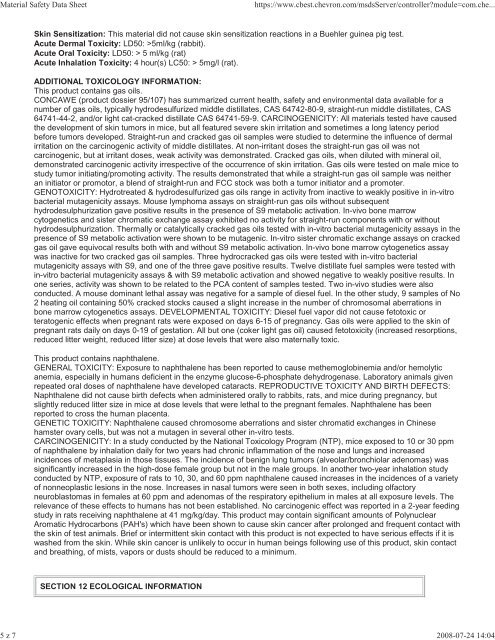Print MSDS - Miller Electric Company Publications
Print MSDS - Miller Electric Company Publications
Print MSDS - Miller Electric Company Publications
You also want an ePaper? Increase the reach of your titles
YUMPU automatically turns print PDFs into web optimized ePapers that Google loves.
Material Safety Data Sheet https://www.cbest.chevron.com/msdsServer/controller?module=com.che...<br />
Skin Sensitization: This material did not cause skin sensitization reactions in a Buehler guinea pig test.<br />
Acute Dermal Toxicity: LD50: >5ml/kg (rabbit).<br />
Acute Oral Toxicity: LD50: > 5 ml/kg (rat)<br />
Acute Inhalation Toxicity: 4 hour(s) LC50: > 5mg/l (rat).<br />
ADDITIONAL TOXICOLOGY INFORMATION:<br />
This product contains gas oils.<br />
CONCAWE (product dossier 95/107) has summarized current health, safety and environmental data available for a<br />
number of gas oils, typically hydrodesulfurized middle distillates, CAS 64742-80-9, straight-run middle distillates, CAS<br />
64741-44-2, and/or light cat-cracked distillate CAS 64741-59-9. CARCINOGENICITY: All materials tested have caused<br />
the development of skin tumors in mice, but all featured severe skin irritation and sometimes a long latency period<br />
before tumors developed. Straight-run and cracked gas oil samples were studied to determine the influence of dermal<br />
irritation on the carcinogenic activity of middle distillates. At non-irritant doses the straight-run gas oil was not<br />
carcinogenic, but at irritant doses, weak activity was demonstrated. Cracked gas oils, when diluted with mineral oil,<br />
demonstrated carcinogenic activity irrespective of the occurrence of skin irritation. Gas oils were tested on male mice to<br />
study tumor initiating/promoting activity. The results demonstrated that while a straight-run gas oil sample was neither<br />
an initiator or promotor, a blend of straight-run and FCC stock was both a tumor initiator and a promoter.<br />
GENOTOXICITY: Hydrotreated & hydrodesulfurized gas oils range in activity from inactive to weakly positive in in-vitro<br />
bacterial mutagenicity assays. Mouse lymphoma assays on straight-run gas oils without subsequent<br />
hydrodesulphurization gave positive results in the presence of S9 metabolic activation. In-vivo bone marrow<br />
cytogenetics and sister chromatic exchange assay exhibited no activity for straight-run components with or without<br />
hydrodesulphurization. Thermally or catalytically cracked gas oils tested with in-vitro bacterial mutagenicity assays in the<br />
presence of S9 metabolic activation were shown to be mutagenic. In-vitro sister chromatic exchange assays on cracked<br />
gas oil gave equivocal results both with and without S9 metabolic activation. In-vivo bone marrow cytogenetics assay<br />
was inactive for two cracked gas oil samples. Three hydrocracked gas oils were tested with in-vitro bacterial<br />
mutagenicity assays with S9, and one of the three gave positive results. Twelve distillate fuel samples were tested with<br />
in-vitro bacterial mutagenicity assays & with S9 metabolic activation and showed negative to weakly positive results. In<br />
one series, activity was shown to be related to the PCA content of samples tested. Two in-vivo studies were also<br />
conducted. A mouse dominant lethal assay was negative for a sample of diesel fuel. In the other study, 9 samples of No<br />
2 heating oil containing 50% cracked stocks caused a slight increase in the number of chromosomal aberrations in<br />
bone marrow cytogenetics assays. DEVELOPMENTAL TOXICITY: Diesel fuel vapor did not cause fetotoxic or<br />
teratogenic effects when pregnant rats were exposed on days 6-15 of pregnancy. Gas oils were applied to the skin of<br />
pregnant rats daily on days 0-19 of gestation. All but one (coker light gas oil) caused fetotoxicity (increased resorptions,<br />
reduced litter weight, reduced litter size) at dose levels that were also maternally toxic.<br />
This product contains naphthalene.<br />
GENERAL TOXICITY: Exposure to naphthalene has been reported to cause methemoglobinemia and/or hemolytic<br />
anemia, especially in humans deficient in the enzyme glucose-6-phosphate dehydrogenase. Laboratory animals given<br />
repeated oral doses of naphthalene have developed cataracts. REPRODUCTIVE TOXICITY AND BIRTH DEFECTS:<br />
Naphthalene did not cause birth defects when administered orally to rabbits, rats, and mice during pregnancy, but<br />
slightly reduced litter size in mice at dose levels that were lethal to the pregnant females. Naphthalene has been<br />
reported to cross the human placenta.<br />
GENETIC TOXICITY: Naphthalene caused chromosome aberrations and sister chromatid exchanges in Chinese<br />
hamster ovary cells, but was not a mutagen in several other in-vitro tests.<br />
CARCINOGENICITY: In a study conducted by the National Toxicology Program (NTP), mice exposed to 10 or 30 ppm<br />
of naphthalene by inhalation daily for two years had chronic inflammation of the nose and lungs and increased<br />
incidences of metaplasia in those tissues. The incidence of benign lung tumors (alveolar/bronchiolar adenomas) was<br />
significantly increased in the high-dose female group but not in the male groups. In another two-year inhalation study<br />
conducted by NTP, exposure of rats to 10, 30, and 60 ppm naphthalene caused increases in the incidences of a variety<br />
of nonneoplastic lesions in the nose. Increases in nasal tumors were seen in both sexes, including olfactory<br />
neuroblastomas in females at 60 ppm and adenomas of the respiratory epithelium in males at all exposure levels. The<br />
relevance of these effects to humans has not been established. No carcinogenic effect was reported in a 2-year feeding<br />
study in rats receiving naphthalene at 41 mg/kg/day. This product may contain significant amounts of Polynuclear<br />
Aromatic Hydrocarbons (PAH's) which have been shown to cause skin cancer after prolonged and frequent contact with<br />
the skin of test animals. Brief or intermittent skin contact with this product is not expected to have serious effects if it is<br />
washed from the skin. While skin cancer is unlikely to occur in human beings following use of this product, skin contact<br />
and breathing, of mists, vapors or dusts should be reduced to a minimum.<br />
SECTION 12 ECOLOGICAL INFORMATION<br />
5 z 7 2008-07-24 14:04



